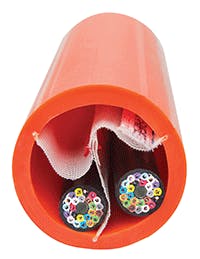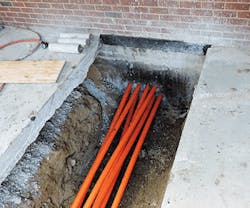Making Room for the Future
Strategies to Combat Shrinking Underground Space —
With 5G being deployed in early markets, consumers are demanding more connectivity and lightning-fast speeds. Cybersecurity is a real concern, and manufacturers are connecting more machinery and devices to the Internet of Things (IoT).
To those of us in the telecommunications industry, all this advancement boils down to one primary need: increased bandwidth.
While adding more bandwidth sounds simple, it requires space. Higher bandwidth means more fiber optic cables underground. And cables are increasing in size as they increase in bandwidth. For example, some 3,456-count fibers are nearly 1.5 inches in diameter. Higher bandwidths can have a significant impact on underground real estate.
It used to be that underground space wasn’t considered a commodity because it was so abundant. These days, however, it’s becoming scarcer as it’s quickly taken up with multiple utilities — and, yes, bandwidth. How we address shrinking underground space will set us up for future success.
InvisiLight® Solution for Deploying Fiber
April 2, 2022Go to Market Faster. Speed up Network Deployment
April 2, 2022Episode 10: Fiber Optic Closure Specs Explained…
April 1, 2022Food for Thought from Our 2022 ICT Visionaries
April 1, 2022Urban Challenges
In urban areas, specifically, the availability of underground space is a growing concern. It’s not uncommon, for example, to have underground space that’s shared by both utilities and telecom providers. Even though underground lines may be buried at different depths, the crowding can be a serious concern. In city environments, underground space is often such a rare commodity that the same conduit may have several different owners. All this crowding leads to marginal space available for expansion.
Another issue that faces urban installers is the need for minimal disruption. Installing new fiber or even performing maintenance on existing fiber can be a significant hassle within city confines. There’s an added pressure on engineers in urban environments to ensure any projects are quick and hassle free, allowing the usual ebb and flow to remain undisturbed.
5G Integration
The arrival of 5G is another ground-consuming factor. With 5G, many antennas are closely arrayed to provide coverage, almost like a huge Wi-Fi network. This densification requires antennas to be closer to end users than 4G did, and many of those antennas are required in urban areas, where available space is already an issue. Even though antennas will be transmitting to connected devices, fiber with high bandwidth will have to run to those antennas.
The constant need for higher bandwidth combined with the fiber demand that 5G will bring makes the scarcity of underground space a growing concern for everyone in the telecommunications industry.
The Edge
5G isn’t the only factor that’s causing more fiber deployment to occur closer to urban areas. The rise of cloud computing requires even shorter latency periods, which means data centers are moving closer to end users. We have already seen data centers built in suburban areas of Atlanta, Dallas, Chicago, and Miami.
As data centers in urban areas continue to need to expand and evolve to meet current demands, they’ll require significant amounts of underground space in order to maintain the necessary bandwidth. Data center growth is just one more reason our underground availability is rapidly shrinking.
3 Ways to Future Proof
The solution to this growing problem of reduced underground availability is future proofing. Our mindset cannot be just catching up or meeting the current demand; we need to be several steps ahead in order to be successful.
Far too often, engineers and contractors alike are looking at the project that’s right in front of them instead of considering how it could be impacted by future needs. We have to start anticipating how to leave physical space for expansions, upgrades, or changes, that need to occur — and to factor in how to do so while avoiding or minimizing civil disruptions. As space becomes more limited, we have to design infrastructure with the future in mind, even if we aren’t sure yet what the future holds.
When designing new construction, it’s increasingly important that engineers not only meet present needs but also incorporate strategies for future changes. But these options do not have to be significant or even disrupt current processes to have a significant positive impact on future flexibility.
Figure 1. In this example, segmented conduits provided multiple pathways for the University of Iowa to share space with Iowa City.
1. Install segmented conduits
One of the best ways to maximize underground real estate is to leverage the space inside the conduits that are installed. Often, there’s plenty of unused space below the recommended fill ratio in the conduit. Installing a segmented conduit can help maximize that space. One solution is a rigid, segmented high-density polyethylene (HDPE) conduit with a fabric divider, like Vis™ Divide. This allows for multiple pathways within the same conduit so future cables can be installed without running the risk of cable-over-cable damage. (See Figure 1.)
It’s a common future-proofing practice to install 2 conduits, creating an extra pathway for future upgrades. Installing 1 segmented conduit provides the same solution while taking up less real estate and less installation time.
Segmented conduits can also assist with providing a way for multiple providers to share space. Access conduits are specifically an area that quickly becomes crowded with demand from multiple providers, such as cable, security, and landlines. Segmented conduits provide a pathway for each provider and help keep cables organized efficiently.
Figure 2. Segmented conduits are installed in the same manner as standard HDPE conduits.
These are a preferred option for future-proofing because they are installed in the same manner as standard HDPE conduits, requiring no additional training or proprietary equipment. Cables are placed into the pathways using traditional pulling methods. No learning curve for contractors makes segmented conduits a low risk solution for maximizing underground space. (See Figure 2.)
Figure 3. Foam makes a great temporary seal so segmented conduits can be easily accessed in the future.
2. Utilize temporary seals
The need for future maintenance is an inevitable reality that can and should be recognized by using temporary seals on ductwork. Seals like reusable inflatable bags or mechanical plugs provide easy, quick access to conduits. While it’s true that contractors can still access conduits with permanent, hardened compound seals, it adds an extra layer of complication that can be both time consuming and costly. It’s far more efficient for contractors to seal ducts with something more temporary, acknowledging the need for future convenience to help minimize civil disruptions. (See Figure 3.)
3. Maximize existing ductwork
As upgrades are needed, making the most out of existing ductwork is often the best option for limited disruptions to everyday workflow. In order to do that, engineers should consider how to best utilize space inside the ductwork.
Incorporating fabric innerduct into existing ducts allows for network expansion within the same conduit. Even if existing conduits have cables already inside, there may be room for more with a fabric innerduct in an overlay application. The innerduct helps to prevent both pulling friction and tension and is a good solution for data centers or other high-bandwidth areas.
A study performed at the Corning Green Acres Test Facility in Hickory, North Carolina, in November 2018 found that fabric innerduct can hold four 3,456-count fiber optic cables in a four-inch conduit — over 13,000 fibers in an area that typically holds half that.
Like this Article?
Subscribe to ISE magazine and start receiving your FREE monthly copy today!
Future Lens
Even when underground space is at a premium, there are future-proofing options available that can make the most of existing infrastructure — and help save both money and time in the process.
The onus is on the entire industry to look at underground construction with a future lens. Engineers should be specifying solutions that allow for future expansion and easy maintenance. Contractors should be evaluating their work with the mindset of simplifying future processes. Through future-proofing, we set ourselves up for success.
About the Author








